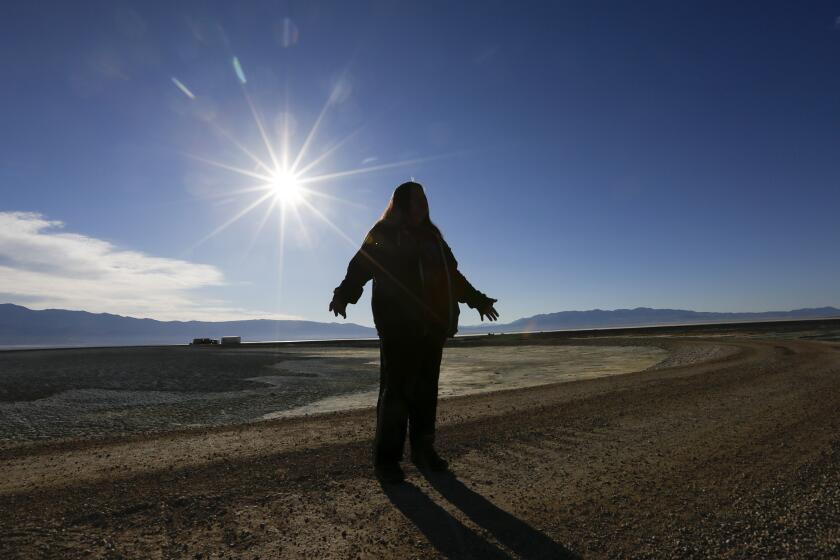
- Share via
- In Owens Valley, where water diversions by Los Angeles have dried up Owens Lake, dust rising from the dry lake bed is a longstanding problem. Now, scientists have found that dust emissions from the lake bed are down, but other desert areas remain a significant source of airborne dust.
- Scientists say their findings can help inform efforts to control lung-damaging dust from sources around the lake.
The dry bed of Owens Lake has long been a major source of dust in the Owens Valley, but mitigation efforts have reduced those emissions to a point that other dust sources in the surrounding desert now cause most of the poor air quality days in the area, according to a new report.
Owens Lake was left desiccated after Los Angeles began tapping the eastern Sierra watershed for its own needs more than a century ago. But the amount of dust coming from the lake bed has been declining in recent years as the L.A. Department of Water and Power has taken mitigation measures such as spreading water on parts of the lake bed.
“This is a success story in process,” said Ted Russell, a professor of civil and environmental engineering at Georgia Institute of Technology and chair of the Owens Lake Scientific Advisory Panel. “You want to be able to understand where these sources are, such that you can better control them.”
The panel, which was established in 2018 by the National Academies of Sciences, Engineering, and Medicine, released its report this week detailing research and data on off-lake sources of dust also known as PM10 — particulate matter that measures 10 microns or smaller, and that penetrates into the lungs and can cause health problems.
In 1924, Owens Valley residents seized the L.A. Aqueduct in a defiant protest. An event focuses on remembering the troubled chapter of L.A. water history.
The team said in the report that significant dust sources in areas around the lake include land where floods have left deposits of sand and debris, the Keeler Dunes, the Olancha Dunes, alluvial fans and areas where soil has been disturbed for road infrastructure.
The scientists said some of these areas are naturally sources of dust, while others are emitting more of it because of diversions of water or alterations of the landscape by people.
Russell said research shows that the DWP’s dust control efforts have been successful in reducing PM10 emissions from the lake bed, as well as the frequency of exceedances of air quality standards.
The DWP has invested about $2.5 billion in dust mitigation projects on the dry lake bed, using methods including the shallow flooding of the lake bottom, placement of gravel, tillage that roughens the soil and the planting of vegetation that serves as a windbreak.
The days with air quality exceedances caused by sources other than the lake have gone up and down in recent years, without a clear trend, Russell said.
“Off-lake sources in this arid environment are significant and are driving a large number of the PM10 exceedances at this time,” Russell said. He said that means bringing the area into attainment with national air quality standards will require additional effects to control the dust sources other than the lakebed.
The report was sponsored by the DWP and the Great Basin Unified Air Pollution Control District, which regulates air pollution in an area of about 32,000 people.
The DWP had no immediate comment on the panel’s findings.
The Los Angeles Department of Water and Power has accused Owens Valley pollution regulators of trying to ‘squeeze’ cash from the utility’s water customers.
The scientists noted that on the northeastern side of Owens Lake, the Keeler Dunes transitioned during the last century from a “largely vegetated dune system” to one that releases more dust. They wrote that “increased sand transport following the diversion of water from Owens Lake destabilized the Keeler Dunes.”
The scientists said ongoing efforts to stabilize the Keeler Dunes have been effective in mitigating dust. The work there has included arranging bales of straw on the sand, which has enabled native shrubs to take root and begin to keep down the blowing dust.
The panel said these and other efforts to establish native vegetation hold promise to control dust in other areas and further improve air quality in the Owens Valley.











